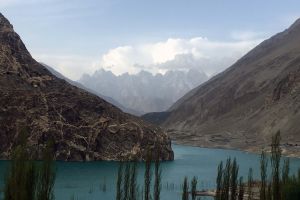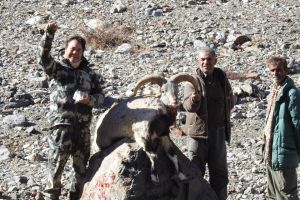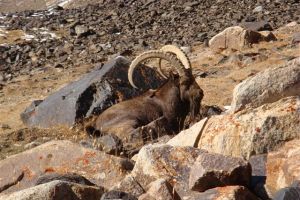Ibex Hunting in Pakistan
Our partner offers challenging hunting for two distinctive species of ibex: Himalayan Ibex which is hunted in the almost inaccessible mountains in the north and the Sindh ibex which is hunted in the less daunting mountains of the south

Highlights
- Challenging Mountain Hunting
- Fantastic Surroundings
- Exciting Culture
It is not by chance that the world’s different ibex species are considered by many passionate mountain hunters to be their greatest challenge. The ibex lives high up in some of wildest mountain ranges on earth, and you must be prepared to undergo strenuous physical challenges, if you are to succeed in adding this trophy to your collection. Zoon Safari offers hunting for two fifferent species of Ibex in Pakistan: Himalayan Ibex which is hunted in the almost inaccessible mountains in the north and the Sindh ibex which iis found in the less daunting mountains of the south.
Himalayan Ibex
Himalayan Ibex (Capra sibirica sakeen) is a sub species of the Siberian ibex and is reminiscent of the Alpine “steinbock”. It is primarily found in the mountain ranges in the north of the country, the Karakorum, western Himalaya and Hindukush, where it can be hunted at an altitude of between 3.000-3.500 m above sea level from November to March. The hunt is both physically and technically challenging, demanding that you are physically well prepared and that you have first rate equipment. During this time of year you can expect temperatures of between 0 to -15 degrees Celcius. Bucks with 38” horn is considered representative, 40” is a realistically achievable trophy size, while a real record class trophy can be as large as 46”. Succes rates on these hunts – measured by game shot with trophies of 38” or above - is very high.
The hunting itself is carried out on foot up in the mountains, where you spot and stalk selected bucks. You should be prepared to shoot from long range and often from a difficult angle in an open mountain landscape. There will be five full hunting days available, while the whole tour stretches out over 11 days. As the hunt takes place in some of the worlds most inaccessible areas, you can expect a relatively demanding journey, which can either include a chartered small aircraft flight, or a long car journey (14 hours/570 km) along twisting mountain roads. Accommodation will be in small local hotels or in private homes and includes full board. During the hunt English speaking staff will be present.
Sindh Ibex
Sindh Ibex (Capra aegagrus blythi ) is slightly smaller and has a lighter coloured coat than the Turkish Bezoar Ibex, of which it is a sub species and looks very similar in type. Sindh Ibex is primarily found in the southern part of Pakistan, where it can be hunted at altitudes of between 0-3.000 m above sea level from November to March. Bucks with 38” horn is considered representative, 40” is a realistically achievable trophy size. Succes rates on these hunts – measured by game shot with representative trophies or above - is very high.
The hunting itself is carried out on foot up in the mountains, where you spot and stalk selected bucks. You should be prepared to shoot from long range and often from a difficult angle in an open mountain landscape. There are two hunting days available, which experience has shown to be enough. The hunts take place in districts that lies roughly a three hour drive away from Karachi along relatively good roads. Accommodation will be in small local hotels or in private homes and includes full board. During the hunt English speaking staff will be present.
General
Only a limited number of licenses fare available for the whole country, and the price of these license will vary from year to year. Pakistan actively uses the trophy fees as an important incentive for wildlife preservation simply by distributing 80% of the funds raised to the local population living in the district where the game was shot, while the final 20% goes to the state’s game administration service. As a hunter it is important that you are aware that the license is used and the trophy fee due at the moment you take your shot – regardless on wether it results in a kill, a wounding or even a miss.
Pakistan is a muslim country and the culture here is very different from Europe. Expect to enjoy an exciting meeting of cultures. Your own weapons can be brought into the country without problem, but expect a processing time for an import permit to take at least four months.
There hunts can be supplemented with reasonably priced wild boar hunts in the Punjab province.
Accommodation

Accommodation - Pakistan
Zoon Safari unusually use either local hotels or private bungalows as accommodation for their guests. Standards vary from district to district, but you will always enjoy full board and a clean bed to sleep in. There will always be an English speaking PH or an interpreter available during your stay in Pakistan. If you are interested in a specific arrangement, Zoon Safari can naturally give much...
Read moreHunting Area

Hunting Districts - Pakistan
Many different districts are used in the hunts for the different game species available in Pakistan. This is because the species available for hunting are spread out over much of the country – often you can only hunt one species in each district, and as the licenses are relatively few in number, you may only hunt in the district that has been allocated. Generally, this system ensures that...
Read morePartner

Zoon Safari
Zoon Safari has many years experience of arranging successful hunts in Pakistan. They are used to hosting European clients and have built up a solid reputation for high quality thought the process, from the planning stage to the hunt itself and all the practical details that need to be done after the hunt is over. In principle Zoon Safaris can arrange all types of hunt that are legal in...
Read moreGame

Ibex (Asia)
Videnskabeligt navn: Capra ibex Underarter: Af 3 beskrevne underarter(Alpestenbuk, Pyrenæisk stenbuk og Sibirisk) forekommer kun sidstnævnte i regionen: Sibirisk stenbuk (Capra ibex sibirica). Udbredelse: Afghanistan, Pakistan, Mongoliet, Kashmir til Kina, Pamir-Tienschan- Altai-Sajan-bjergkæden. Levested: Højalpine områder, som regel over trægrænsen,...
Read more
Tahr, Himalayan (Asia)
Scientific Name: Hemedragus jemlahicus Subspecies: None. Distribution: Kashmir to Nepal. (In 1904 the Himalayan Tahr was introduced into New Zealand from English game park stocks (see. Indo-pacific region). From there they were introduced into California, Florida and Texas (USA) and South Africa (Table Mountain on the Cape)). Habitat: Mountain forest with open grassy areas between 1.200 and...
Read morePrices

The price includes
- All transport in the hunting district
- Accommodation in a hotel or hunting camp with full board
- All hunting, trophy fee and field preparation of the trophy
- English speaking interpreter or English speaking PH
- Import of weapons
- Visa and all other necessary documentation
The price does not include
- Return flight to and from your final airport destination
- Car transport to the hunting district
- Gratuities
- Alcoholic drinks
- Any hotel accommodation before or after the hunt




































